

Literacy Today - teacher inspired Secondary ELA resources. Control Alt Achieve: Improve Reading Comprehension with Google Docs "Black Out" Some key goals for literacy are reading comprehension, being able to identify main ideas, and summarization skills.
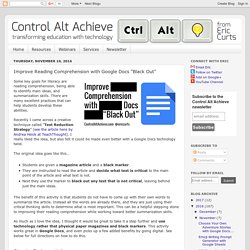
There are many excellent practices that can help students develop these abilities. Recently I came across a creative technique called “Text Reduction Strategy” (see the article here by Andrea Heick at TeachThought). James Gee: Literacy.
Structure of minilessons. Secondary Literacy / Literacy Online / English - ESOL - Literacy Online website - English - ESOL - Literacy Online. Tips To Have Students Ask Better Questions. Reading Is Fundamental. Character. Teaching Students the Skills of Expert Readers. Research shows that skilled or expert readers possess seven strategies to construct meaning before, during, and after reading a text.

When skilled students read, it is an active process. Their minds are constantly processing information extracted from the text, e.g., questioning the author, summarizing passages, or interpreting images. Contrarily, struggling readers often unthinkingly read the words on the page. For them, reading is an inactive activity. Constructing meaning from the text does not naturally occur in the mind of a struggling reader. Fortunately, the cognitive skills of expert readers can be taught. 7 Strategies Below is a summary of the seven strategies of highly skilled readers. 1. 2. 3. 4. 5. 6. 7.
Text complexity, leveling, leveled books, reader and task, common core standards, appendix a, ccss. Lately, as I’ve been trying to help teachers whose states mandate moving kids through reading levels — called “SGO” or “SLO” or something else depending on where I am — I’ve been finding myself talking about the interplay between reader, task, and text.
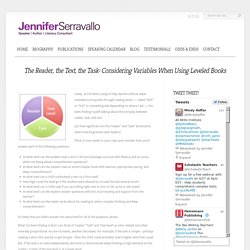
Just how significant are the “reader” and “task” dimensions when matching books and readers? Think of one reader in your class and consider how you’d answer each of the following questions: At what level can the student read a short 100 word passage out loud with fluency and accuracy when not being asked comprehension questions?
At what level can the student read an entire chapter book with stamina, appropriate pacing, and deep comprehension? At what level can a child understand a text on a first read? The Reading Strategies Book by Jen Serravallo. A Very Brief Introduction to Principles, Research, and Theory, and How to Use This Book When I showed an early draft of this book to a colleague, she remarked, "It's like you're making a reading teacher's version of Mark Bittman's How to Cook Everything!
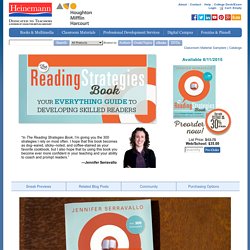
" (2008) I could see the analogy-this is a book of "reading recipes" in a way. The Reading Strategies Book. Jennifer Serravallo is unquestionably a leader when it comes to advancements in both reading and writing instruction.
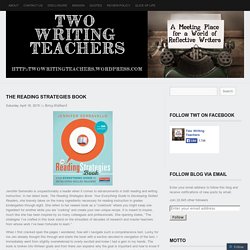
In her latest book, The Reading Strategies Book: Your Everything Guide to Developing Skilled Readers, she bravely takes on the many ingredients necessary for reading instruction in grades kindergarten through eight. She refers to her newest book as a “cookbook” where you might swap one ingredient for another while you are “cooking” and create your own unique recipe. It is meant to inspire, much like she has been inspired by so many colleagues and professionals. She opening states, “The strategies I’ve crafted in this book stand on the shoulders of decades of research and master teachers from whose work I’ve been fortunate to learn.”
Interactive Reading Strategies. Reading aloud is an important skill, but it can be all too easy for us to allow this activity to become mundane and detached by repeatedly conducting “popcorn reading” or simply reading aloud to the class and asking students questions.
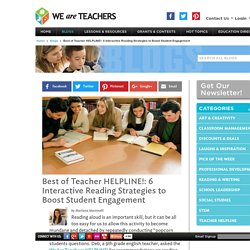
Deb, a 9th grade english teacher, asked the WeAreTeachers HELPLINE! For recommendations on reading strategies to promote student engagement. Read on to learn six strategies for interactive reading that are recommended for teachers, by teachers. Learning English through picture books. By Opal Dunn, author and educational consultant Every year thousands of children’s picture books are published in the UK.
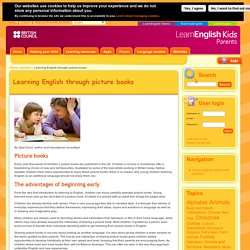
Children’s corners in bookshops offer a bewildering choice of new and old favourites, illustrated by some of the best artists working in Britain today. Native-speaker children have many opportunities to enjoy these picture books; there is no reason why young children learning English as an additional language should not enjoy them, too. From the very first introduction to listening to English, children can enjoy carefully selected picture books. Young learners soon pick up the short text of a picture book, if initially it is shared with an adult who brings the pages alive. Strega Nona Interactive Read Aloud.
11 Alternatives to "Round Robin" (and "Popcorn") Reading. Spotlighting Online Literacy Resources. As 2015 quickly approaches, it is a perfect time to reflect and set some new goals.
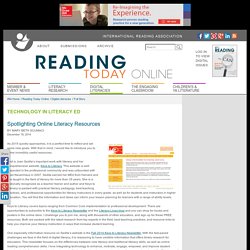
With that in mind, I would like to introduce you to some incredibly useful resources. First is Joan Sedita’s important work with literacy and her comprehensive website, Keys to Literacy. This website is well respected in the professional community and was cofounded with Brad Neuenhaus in 2007. Sedita earned her MEd from Harvard and has taught in the field of literacy for more than 35 years. The Secret of Literacy by @LearningSpy. Despite a pile of education books reaching in-excess of 20-high, the only book I’ve managed to read from cover to cover this summer is David Didau’s, The Secret of Literacy.
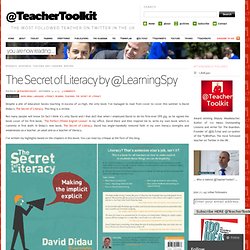
This blog is a review. Not many people will know (in fact I think it’s only David and I that do!) That when I employed David to do his first-ever CPD gig, as he signed the book cover of his first book, ‘The Perfect Ofsted English Lesson‘ in my office, David there and then inspired me to write my own book which is currently in first draft.
Reading 'can help reduce stress' Subjects only needed to read, silently, for six minutes to slow down the heart rate and ease tension in the muscles, he found.
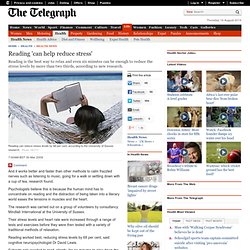
In fact it got subjects to stress levels lower than before they started. Listening to music reduced the levels by 61 per cent, have a cup of tea of coffee lowered them by 54 per cent and taking a walk by 42 per cent. Playing video games brought them down by 21 per cent from their highest level but still left the volunteers with heart rates above their starting point. Dr Lewis, who conducted the test, said: "Losing yourself in a book is the ultimate relaxation. Throwback Week: How To Read A Unit of Study. Have you ever thought of the TCRWP’s Units of Study as a script? If you have, then you’re not alone. However, they’re NOT a script! If you’ve ever been unsure of how to read the Units of Study books, then this Throwback Week post is for you!
Six months ago, Beth Moore, who is a staff developer for the TCRWP and a co-author of the Units of Study books, penned a post with a few key steps to getting the most out of the TCRWP Units of Study. Educational Technology and Mobile Learning: Critical Digital Literacy Explained for Teachers. 11 Alternatives to "Round Robin" (and "Popcorn") Reading. Creating Character Blogs. Home › Classroom Resources › Lesson Plans Lesson Plan Overview Featured Resources From Theory to Practice In this lesson, students view examples of appealing blogs, learn the basic elements of blog creation, and then create a blog from the perspective of a fictional character.
Back to top Character Blog Requirements: This handout explains the requirements for creating character blogs. Leu, D.J., Jr., Kinzer, C.K., Coiro, J., & Cammack, D.W. (2004). The integration of new media literacies into traditional curricula is increasingly important. Electronic Assessment Summary Charts.xlsx. NEWSELA + Google Docs = Differentiated, Collaborative Reading!
This is a guest post from Beth Holland of EdTechTeacher.org, an advertiser on this blog. Celebrate International Literacy Day! Grades K – 2 | Lesson Plan | Recurring Lesson Learning Centers: From Shared to Independent Practice Seven blind mice—see how they spend each day of the week in this lesson that uses the book Seven Blind Mice to guide students through shared reading, writing, and listening activities. Grades 6 – 8 | Lesson Plan | Standard Lesson E-pals Around the World With e-pals, students develop real-life writing and social experiences, learn the format of a friendly letter and parts of an e-mail message, and discover other cultures, languages, and geographic areas. Grades 9 – 12 | Lesson Plan | Standard Lesson. LITERATURE CIRCLE BOOKLETS. 21 Cool Anchor Charts To Teach Close-Reading Skills. VM0221Teaching. Five Strategies to Implement Immediately Based on Regie Routman’s Best Practices. Teaching Character: The Choices We Make. Reading Idea: analyzing a character - The Mailbox.
Science. Digital literacy. Reading workshop. Formative. Guided reading. Think-pair-share. Think-alouds. Charts. Strategies. Story maps. Common Core. Setting. About reading / literacy. Videos. Close reading. Literature. Visuals. Teaching Sequence. Kids easily learn that one thing follows another. Their routines at home provide great examples, and are a good introduction to the concept of sequencing. For example, first we eat dinner, then we take a bath, after that we read stories, and finally we turn out the light. Helping children sequence also develops their scientific inquiry skills.
In order to study or observe changes in something, students must follow along and record changes. The changes happen in a particular order, which kids can document by writing or drawing pictures. Here are a few activities that families can do that provide children with sequencing practice. Cut or tear out the pages from an old calendar. Providing your child with opportunities to recall events in the correct sequence will help your child as she participates in science exploration and discovery. Bringing the Rain to Kapiti PlainBy Verna Aardema Purchase book Every Autumn Comes the BearBy Jim Arnosky.
Exploring Literacy in Cyberspace. ReadWriteThink couldn't publish all of this great content without literacy experts to write and review for us. If you've got lessons plans, videos, activities, or other ideas you'd like to contribute, we'd love to hear from you. More Find the latest in professional publications, learn new techniques and strategies, and find out how you can connect with other literacy professionals. More Teacher Resources by Grade Your students can save their work with Student Interactives. More Home › Classroom Resources › Lesson Plans Lesson Plan. Balanced Literacy - Teaching Reading and Writing With a Balanced Literacy Program. Comparing and Contrasting with the Three Little Pigs.
We keep hoping for snow here in middle Tennessee. We got so close yesterday, but nothing! Read With Me: 5 Tips to Foster a Love for Reading.